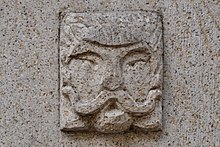Goose Rider Fountain
The Gänsereiterbrunnen stands on the square behind the Apostle Church in Essen 's Frohnhausen district . It was built in 1913 and listed as a historical monument in 1994 .
history
Design and creation
The design of the fountain comes from the Hagen architect Ewald Wachenfeld. The name Gänsereiterbrunnen goes back to the folk custom of goose riding , which was probably cultivated in Frohnhausen until the end of the 19th century. In the discussion of the fountain design, instead of the fire-gilded bronze sculpture of a rider reaching for a goose (lost in World War II ), an alternative was a chicken that would have represented another tradition in the district, namely the carnival custom of the rooster head .
The cost of the goose rider's fountain was shared by the Essen Beautification Association and the city of Essen, which is still the owner today. Standing on Bonner Strasse (today's street name: An der Apostelkirche), the fountain was intended to complement the apostle community center as a decorative system with benches and six linden trees (three of which are still standing today) and primarily serve to beautify the cityscape. As one of three Frohnhauser fountains from the imperial era, it bears witness to the design of a city shaped by Krupp in late Art Nouveau .
War destruction
The goose rider fountain was buried under the rubble of the Apostle Church during bombing during World War II. The fire-gilded bronze sculpture by the British-German sculptor William Ohly (1883–1955) of a rider reaching for a goose, which until then had crowned the fountain, has been missing since then. During the reconstruction, the torn apart core of the well had to be reassembled. Broken parts made of trachyte were replaced by plastered brickwork in the post-war years. The well did not have a new water connection; before the war it was connected to a fresh water pipe. The dolphins and the Art Nouveau masks customary at the time decorated the fountain again later, but without the lost bronze sculpture no longer show its name.
Restoration from 2008 to 2010
Due to the only provisional reconstruction after the war and the later environmental influences, the outside of the well was badly damaged, as was the inside of the well by rainwater that had penetrated. In January 2008, the heavily was in need of restoration Nouveau-style fountain partially dismantled as part of construction work in the redesign of the church square, stored and in Saxony restored. A stonemason from Essen, Eugen Kalenborn, received the restoration contract. The well, consisting of 48 natural stone elements, was peeled off down to the solid material and received the 13 natural stone elements that had been missing since the war. The required replacement rock, trachyte of volcanic origin, comes from Selters . In addition, the fountain got new bronze overflows. The four completely weathered dolphin heads were replaced. The well head crumbled during the restoration due to rusted iron inside.
The goose rider fountain, which weighs around 30 tons, has been located a little in the middle of the newly designed church square since November 2009. It has got a new water connection, which is now operated with a circulation pump and a cistern, as is common today, so that fresh water is not constantly used. The official inauguration and commissioning of the fountain took place on April 17, 2010.
According to an initial external calculation, around 70,000 euros should initially be needed to finance the restoration. The actual costs were significantly higher. Among other things, the Frohnhauser Denkmäler und Kulturwerte e. V.
literature
- Robert Welzel: How Frohnhausen got to the goose rider. Aesthetic aspects of Essen city planning using the example of a fountain. In: Essener contributions , contributions to the history of the city and monastery Essen , Volume 115 (2003), S. #.
Web links
Individual evidence
- ↑ Excerpt from the list of monuments of the city of Essen (PDF; 413 kB); accessed on March 7, 2018
- ↑ Another fountain is on Frohnhauser Platz (market square), as well as a fountain in the inner courtyard of the Luisenhof settlement
- ↑ Stadtspiegel Essen, West-Anzeiger, issue No. 42 of May 27, 2009.
- ↑ Stadtspiegel Essen, West-Anzeiger, issue No. 92 from November 18, 2009.
Coordinates: 51 ° 26 ′ 45.8 " N , 6 ° 58 ′ 26.6" E


